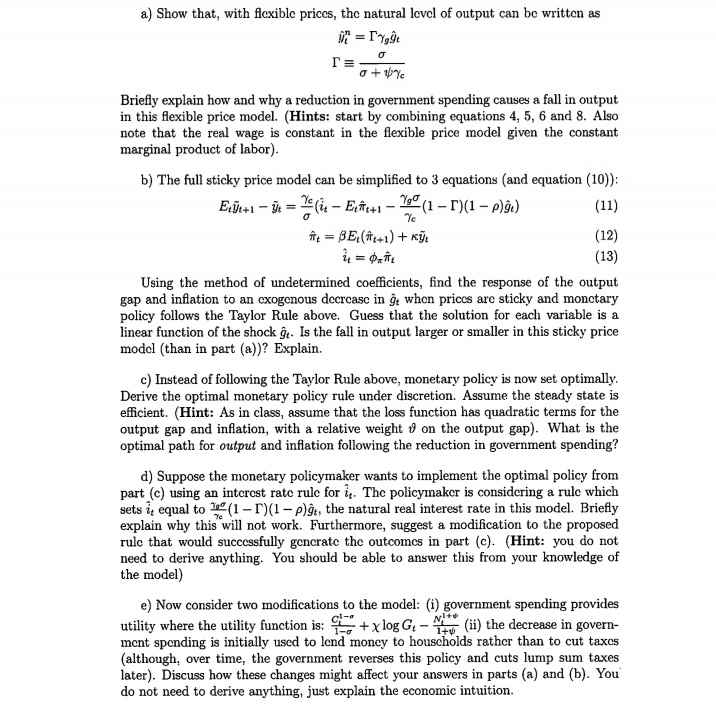
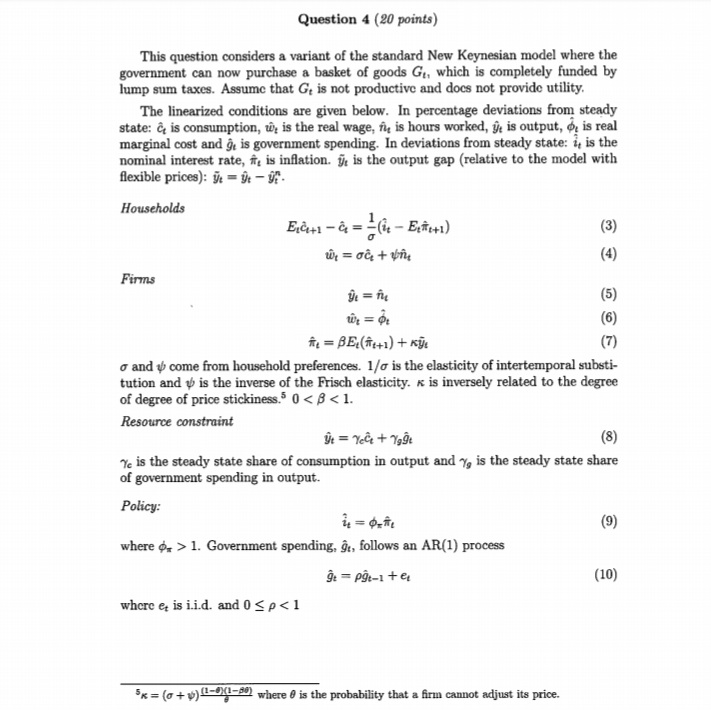

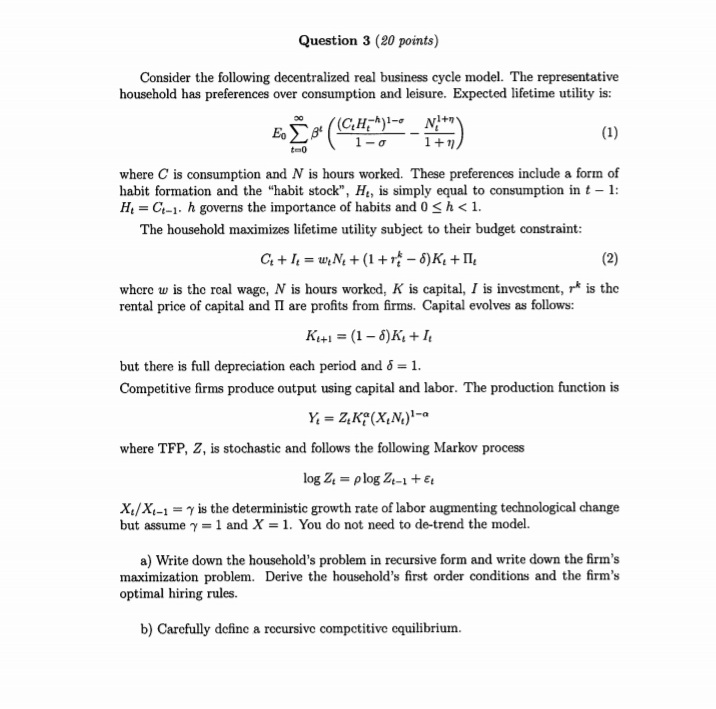
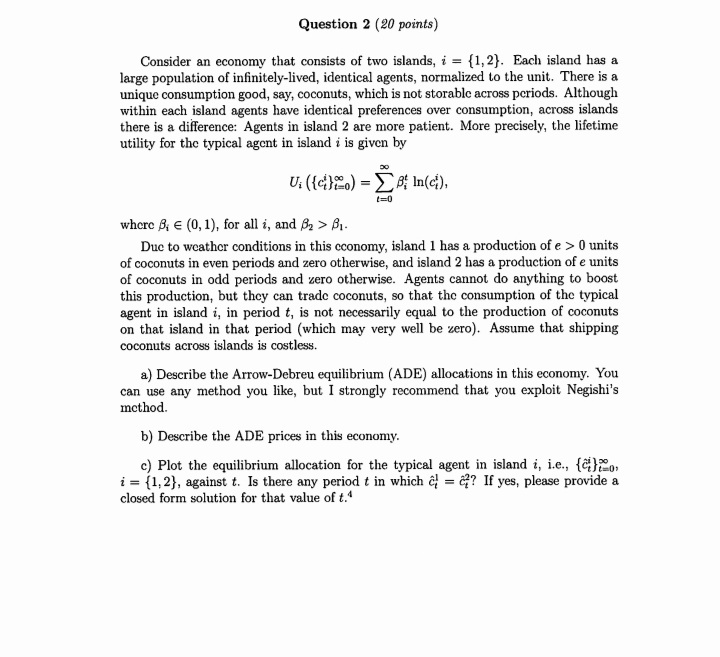
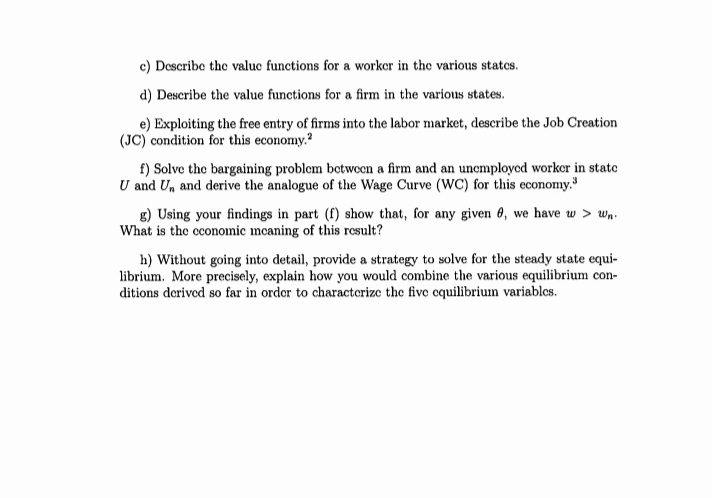
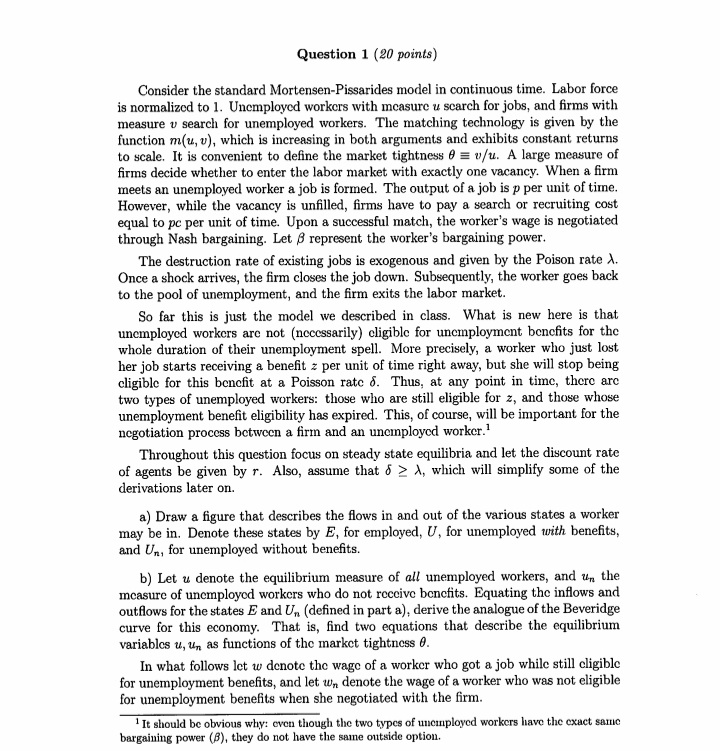
please try and simply the work I will appreciate thankyou
a) Show that, with flexible prices, the natural level of output can be written as IT = ry,9 T= - o+ wy Briefly explain how and why a reduction in government spending causes a fall in output in this flexible price model. (Hints: start by combining equations 4, 5, 6 and 8. Also note that the real wage is constant in the flexible price model given the constant marginal product of labor). b) The full sticky price model can be simplified to 3 equations (and equation (10)): Eidt+1 - 91 = (4 - Eftel - (1 - D)(1 -p)g.) (11) it = BE(# +1) + Ky (12) (13) Using the method of undetermined coefficients, find the response of the output gap and inflation to an exogenous decrease in g, when prices are sticky and monetary policy follows the Taylor Rule above. Guess that the solution for each variable is a linear function of the shock g. Is the fall in output larger or smaller in this sticky price model (than in part (a))? Explain. c) Instead of following the Taylor Rule above, monetary policy is now set optimally. Derive the optimal monetary policy rule under discretion. Assume the steady state is efficient. (Hint: As in class, assume that the loss function has quadratic terms for the output gap and inflation, with a relative weight v on the output gap). What is the optimal path for output and inflation following the reduction in government spending? d) Suppose the monetary policymaker wants to implement the optimal policy from part (c) using an interest rate rule for &. The policymaker is considering a rule which sets it equal to "(1 -D)(1 -p)g:, the natural real interest rate in this model. Briefly explain why this will not work. Furthermore, suggest a modification to the proposed rule that would successfully generate the outcomes in part (c). (Hint: you do not need to derive anything. You should be able to answer this from your knowledge of the model) e) Now consider two modifications to the model: (i) government spending provides utility where the utility function is: 7 + xlog Go - 74% (ii) the decrease in govern- ment spending is initially used to lend money to households rather than to cut taxes (although, over time, the government reverses this policy and cuts lump sum taxes later). Discuss how these changes might affect your answers in parts (a) and (b). You' do not need to derive anything, just explain the economic intuition.Question 4 (20 points) This question considers a variant of the standard New Keynesian model where the government can now purchase a basket of goods G,, which is completely funded by lump sum taxes. Assume that G, is not productive and does not provide utility. The linearized conditions are given below. In percentage deviations from steady state: & is consumption, w, is the real wage, nut is hours worked, y, is output, , is real marginal cost and g, is government spending. In deviations from steady state: i, is the nominal interest rate, #, is inflation. y, is the output gap (relative to the model with flexible prices): yr = ge - yr- Households (3) (4 ) Firms (5) w = 0 (6) it = BE(14+1) + Ky (7) and + come from household preferences. 1/o is the elasticity of intertemporal substi tution and v is the inverse of the Frisch elasticity. * is inversely related to the degree of degree of price stickiness.$ 0 1. Government spending, g:, follows an AR(1) process gt = pgt-1 + et (10) where er is i.i.d. and 0 S p 1 (rather than 81- Due to weather conditions in this cconomy, island 1 has a production of e > 0 units of coconuts in even periods and zero otherwise, and island 2 has a production of e units of coconuts in odd periods and zero otherwise. Agents cannot do anything to boost this production, but they can trade coconuts, so that the consumption of the typical agent in island i, in period t, is not necessarily equal to the production of coconuts on that island in that period (which may very well be zero). Assume that shipping coconuts across islands is costless. a) Describe the Arrow-Debreu equilibrium (ADE) allocations in this economy. You can use any method you like, but I strongly recommend that you exploit Negishi's method. b) Describe the ADE prices in this economy. c) Plot the equilibrium allocation for the typical agent in island i, i.e., {q)., i = {1, 2), against t. Is there any period t in which & = &? If yes, please provide a closed form solution for that value of t.*c) Describe the value functions for a worker in the various states. d) Describe the value functions for a firm in the various states. e) Exploiting the free entry of firms into the labor market, describe the Job Creation (JC) condition for this economy." f) Solve the bargaining problem between a firm and an unemployed worker in state U and U. and derive the analogue of the Wage Curve (WC) for this economy. g) Using your findings in part (f) show that, for any given d, we have w > w,. What is the economic meaning of this result? h) Without going into detail, provide a strategy to solve for the steady state equi- librium. More precisely, explain how you would combine the various equilibrium con- ditions derived so far in order to characterize the five equilibrium variables.Question 1 (20 points) Consider the standard Mortensen-Pissarides model in continuous time. Labor force is normalized to 1. Unemployed workers with measure u search for jobs, and firms with measure u search for unemployed workers. The matching technology is given by the function m(u, v), which is increasing in both arguments and exhibits constant returns to scale. It is convenient to define the market tightness 8 = v/u. A large measure of firms decide whether to enter the labor market with exactly one vacancy. When a firm meets an unemployed worker a job is formed. The output of a job is p per unit of time. However, while the vacancy is unfilled, firms have to pay a search or recruiting cost equal to pc per unit of time. Upon a successful match, the worker's wage is negotiated through Nash bargaining. Let / represent the worker's bargaining power. The destruction rate of existing jobs is exogenous and given by the Poison rate X. Once a shock arrives, the firm closes the job down. Subsequently, the worker goes back to the pool of unemployment, and the firm exits the labor market. So far this is just the model we described in class. What is new here is that unemployed workers are not (necessarily) eligible for unemployment benefits for the whole duration of their unemployment spell. More precisely, a worker who just lost her job starts receiving a benefit z per unit of time right away, but she will stop being eligible for this benefit at a Poisson rate o. Thus, at any point in time, there are two types of unemployed workers: those who are still eligible for z, and those whose unemployment benefit eligibility has expired. This, of course, will be important for the negotiation process between a firm and an unemployed worker.' Throughout this question focus on steady state equilibria and let the discount rate of agents be given by r. Also, assume that 6 2 A, which will simplify some of the derivations later on. a) Draw a figure that describes the flows in and out of the various states a worker may be in. Denote these states by E, for employed, U, for unemployed with benefits, and Un, for unemployed without benefits. b) Let u denote the equilibrium measure of all unemployed workers, and un the measure of unemployed workers who do not receive benefits. Equating the inflows and outflows for the states E and Un (defined in part a), derive the analogue of the Beveridge curve for this economy. That is, find two equations that describe the equilibrium variables u, un as functions of the market tightness 0. In what follows let w denote the wage of a worker who got a job while still cligible for unemployment benefits, and let w, denote the wage of a worker who was not eligible for unemployment benefits when she negotiated with the firm. It should be obvious why: even though the two types of unemployed workers have the exact same bargaining power (8), they do not have the same outside option




















